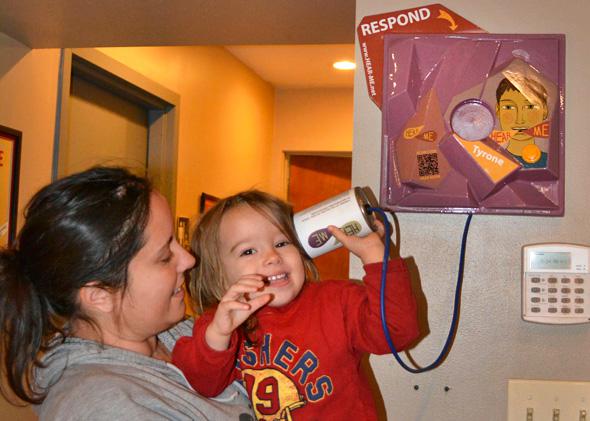The boy’s voice is soft, thoughtful, and a little sad. Zachary, age 10, is describing the bullying he recently saw at school: “I tried to stop it, but they wouldn’t stop,” he says. “They were shoving kids into lockers, pushing them around, chasing after them in the halls, calling names. It made me feel bad because I couldn’t do nothing to stop it.”
You can hear Zachary’s voice on the website for Hear Me, an initiative of the CREATE Lab at Carnegie Mellon University that captures the stories of children and teens using simple microphones and mobile video recorders. But if you live in Pittsburgh, you can also hear his voice—and the voices of hundreds of other kids—as you come across “tin cans” embedded with audio files that have been placed in 24 spots throughout the city. To hear the kids’ voices, press a button or hold the can to your ear. They are part of Hear Me kiosks in coffee shops, libraries, recreation spaces, and, the founders hope, eventually City Hall. “We’re using media to empower kids to talk about serious issues,” said Jessica Pachuta, one of the project managers.
Hear Me has all the ingredients of a feel-good activity for our time: using digital recorders to capture moments and rebroadcast them; linking technology to physical, face-to-face spaces; and giving students a chance to use new tools for self-expression. In education technology debates, excitement always builds when people talk about the power of technology to enable students to see themselves as creators (not just consumers) by posting their projects on sites like YouTube.
But that’s not what is most interesting about the Hear Me project. What caught my attention is what went wrong in the project’s first year—and how the project managers decided to fix it.
“We were originally going to set up a website to start this work,” said Jessica Kaminsky, the other project manager for Hear Me. The goal was to collect 25,000 stories in two years. She and Pachuta imagined kids jumping online and eagerly creating audio and video stories about issues in their lives.
That didn’t happen. Children were not taking part. Stories were not appearing. “People visited the site looking for content, but very few contributed content,” Pachuta said. Before the first year was up, she and Kaminsky realized that “just having a platform wasn’t enough.”
Kaminsky and Pachuta, led by CREATE Lab Director Illah Nourbakhsh, decided to regroup. Watching how children reacted when they would actually reach out and listen to them, face to face, they had an “aha”: They noticed that “people and kids valued having us, or a third party who has legitimacy and skills to work with kids in the way that we do, visit and bring technology, programming, and ideas to them.” So they focused on building relationships with schools and nonprofits that were already involved in activities that involved students. They also decided to hire interviewers, spending almost half of their time on training them to help students feel that their ideas are valued.
Under this new strategy, the project has recorded more than 3,700 stories, all of which can be heard on the Hear Me website. Some are tender, many are eye-opening. On the subject of the necessity of metal detectors, listen to 17-year-old Isac place responsibility at the foot of his peers: “What are you bringing weapons to school for?” On the topic of living in the United States as a refugee, hear 14-year-old Asha describe her Kenyan family and her separation from her brother, whom she hasn’t seen since she was 3.
The project has partnerships with more than 140 organizations, from public schools to arts groups to Amachi, a mentoring group for kids with incarcerated parents. (Full disclosure: Future Tense is a partnership of Slate, the New America Foundation, and Arizona State University. At the New America Foundation in 2012, we worked with Hear Me to capture the voices of children for our ed-tech event “Getting Schooled by a Third Grader,” and the Grable Foundation—one of Hear Me’s many funders—is also among New America’s funders.)
“A huge part of why we’re able to elicit quality stories from students and why students feel empowered by this experience is because there is a relationship between the listener and the speaker,” Kaminsky said.
Hear Me is now less about the technology and more about the guidance and structure—the “scaffolding,” to borrow a favorite term of educators—that comes from mentors sitting with, listening to, and challenging kids to take their ideas to the next level. As Pachuta says: “Personal interaction makes technology meaningful”—and it also makes the technology secondary.
It’s a lesson that bears repeating as Smart Boards have become ubiquitous in today’s classrooms and school districts, such as Los Angeles Unified, are spending millions on fleets of new iPads. Technology rollouts can become a waste of time and money if there isn’t adequate focus on the people who will be interacting with students while using the technology. Larry Cuban’s 2001 warnings about desktop computers being Oversold and Underused could be at risk of becoming true for digital mobile technology today.
This summer, Hear Me launched its first campaign to bring attention to student discipline and school climate, capturing snippets of ideas and complaints from dozens of students. Corey, 18, argued that some of the reason the problems persist at her school is that “you could go to anybody, like the principals and stuff, but students’ voices are never heard.” The hope is that, with the help of the Hear Me staff, they will be.
This article arises from Future Tense, a collaboration among Arizona State University, the New America Foundation, and Slate. Future Tense explores the ways emerging technologies affect society, policy, and culture. To read more, visit the Future Tense blog and the Future Tense home page. You can also follow us on Twitter.
